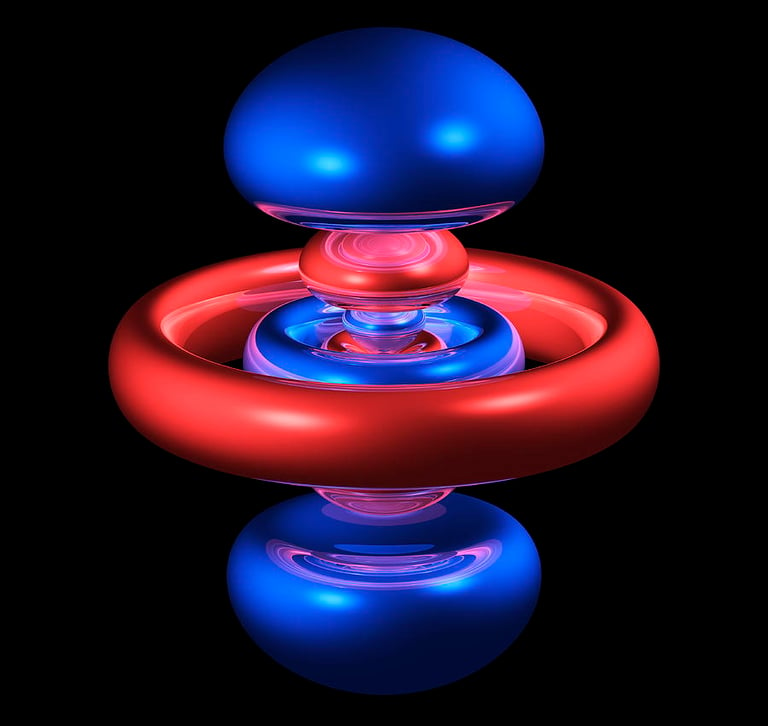
क्या हार में क्या जीत में ! किंचित नहीं भयभीत मैं
संधर्ष पथ पर जो मिले यह भी सही वह भी सही।
वरदान नहीं मानूंगा, हार नहीं मानूंगा |
Atomic Orbital
CHEMISTRY
10/25/20222 min read


Atomic Orbital
An atomic orbital is a mathematical function that describes the probability of finding an electron in a particular region around the nucleus of an atom. These orbitals represent the spatial distribution of electrons and their associated energy levels within an atom.
Concepts of Atomic Orbitals:
Quantum Numbers:
Each atomic orbital is defined by a set of quantum numbers, which describe its size, shape, and orientation in space.
Principal Quantum Number (n): Indicates the main energy level or shell of an orbital. It can take positive integer values (1, 2, 3, etc.). Higher n values correspond to orbitals that are farther from the nucleus and have higher energy.
Azimuthal Quantum Number (l): Also known as the angular momentum quantum number, it defines the shape of the orbital. It can take integer values from 0 to n−1. Each value of l corresponds to a different type of orbital:
l=0 : s-orbital (spherical)
l=1: p-orbital (dumbbell-shaped)
l=2: d-orbital (cloverleaf-shaped)
l=3: f-orbital (complex shapes)
Magnetic Quantum Number (m_l): Defines the orientation of the orbital in space. It can take integer values from −l to +l, including zero. For example, if l=1 (p-orbital), ml can be -1, 0, or +1, corresponding to the three different orientations of p-orbitals.
Spin Quantum Number (m_s): Describes the spin of the electron within an orbital. It can take values of +1/2 or −1/2.
Types of Atomic Orbitals:
s-Orbitals (l = 0):
Spherical in shape.
Each energy level n has one s-orbital.
An s-orbital can hold a maximum of 2 electrons.
p-Orbitals (l = 1):
Dumbbell-shaped with lobes oriented along the x, y, and z axes.
Each energy level n≥2 has three p-orbitals (p_x, p_y, p_z).
Each p-orbital can hold a maximum of 2 electrons, for a total of 6 electrons in the p sublevel.
d-Orbitals (l = 2):
More complex shapes, often described as cloverleaf.
Each energy level n≥3 has five d-orbitals.
Each d-orbital can hold a maximum of 2 electrons, for a total of 10 electrons in the d sublevel.
f-Orbitals (l = 3):
Even more complex shapes.
Each energy level n≥4 has seven f-orbitals.
Each f-orbital can hold a maximum of 2 electrons, for a total of 14 electrons in the f sublevel.
Visualization and Importance:
Probability Distribution:
Atomic orbitals are visualized as regions in space where there is a high probability of finding an electron.
The shape and size of these regions are determined by the quantum numbers.
Electron Configuration:
The arrangement of electrons in atomic orbitals is described by electron configuration, which follows the Aufbau principle, Pauli exclusion principle, and Hund's rule.
Electron configuration determines the chemical properties and reactivity of elements.
Chemical Bonding:
The overlap of atomic orbitals from different atoms forms molecular orbitals, which are crucial for chemical bonding.
The type and shape of orbitals involved in bonding influence the geometry and strength of chemical bonds.
Understanding atomic orbitals is fundamental to comprehending the electronic structure of atoms, the nature of chemical bonds, and the behavior of elements in various chemical reactions.
